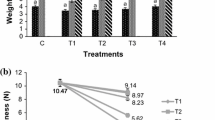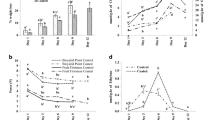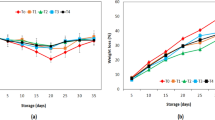Abstract
The aim of the present study was to characterize the physical–chemical and sensory attributes of two papaya varieties (Aliança and Golden THB) (Carica papaya L.) coated with different solutions of manioc starch and clove essential oil (Syzygium aromaticum L. Merr. et Perry). Four different treatments were studied in papaya fruits at ripening stage 1: T0 (control); T1 (fruits coated with a solution of manioc starch); T2 (fruits coated with clove essential oil at 0.175 mL L−1); T3 (solution of manioc starch with clove essential oil—0.175 mL L−1). The physical–chemical and sensory analyses were conducted in the fruits at ripening stage 5. The edible coatings did not influence the physical–chemical characteristics of the two varieties. Those fruits coated with manioc starch reported a good sensory acceptance not differing statistically from the control fruits in the majority of the attributes studied. By evaluating the purchase intention regarding the variety Aliança, all the treatments reported good levels of acceptance, with higher scores in the option “would certainly buy”. After the sensory evaluation, treatment T3 reported a purchase intention of 80%. It was concluded that the edible coatings did not influence the physical–chemical characteristics of the fruits, however, they influenced the sensory acceptance of the tasters. For the variety Aliança, the application of treatment T3 is recommended, while for Golden THB, treatments T1 and T2 are recommended due to their similarity to the control.



Similar content being viewed by others
References
Alali AA, Awad MA, Al-Qurashi AD, Mohamed SA (2018) Postharvest gum Arabic and salicylic acid dipping affect quality and biochemical changes of ‘Grand Nain’ bananas during shelf life. Sci Hortic 237:51–58
Ali A, Hei GK, Keast YW (2016) Efficacy of ginger oil and extract combined with gum arabic on anthracnose and quality of papaya fruit during cold storage. J Food Sci Technol 53:1435–1444
Araujo IMS, Garruti DS, Lima JR, Oliveira DT, Rocha RFJ, Viana ES (2016) Aceitabilidade sensorial de genótipos de mamoeiro do grupo Solo. Embrapa Agroindústria Tropical, Fortaleza
Brito SSS, Silva F, Malheiro R, Baptista P, Pereira JA (2018) Croton argyrophyllus Kunth and Croton heliotropiifolius Kunth: phytochemical characterization and bioactive properties. Ind Crop Prod 113:308–315
Cazane AL, Machado JGCF, Pigatto G (2010) Análise do consumidor de frutas no município de Tupã, Estado de São Paulo. Inf Econ 40:16–29
Choi WS, Singh S, Lee YS (2016) Characterization of edible film containing essential oils in hydroxypropyl methylcellulose and its effect on quality attributes of ‘Formosa’ plum (Prunus salicina L.). LWT Food Sci Technol 70:213–222
Dantas JLL, Junghans DT, Lima JF (2013) Mamão: O produtor pergunta, a Embrapa responde. EdEmbrapa, Brasília
Dong F, Wang X (2017) Effects of carboxymethyl cellulose incorporated with garlic essential oil composite coatings for improving quality of strawberries. Int J Biol Macromol 104:821–826
Fialho RO, Papa MFS, Pereira DAS (2015) Efeito fungitóxico de óleos essenciais sobre Phakopsora euvitis, agente causal da ferrugem da videira. Arq Inst Biol 82:1–7
Flores-López ML, Cerqueira MA, Rodríguez DJ, Vicente AA (2016) Perspectives on utilization of edible coatings and nano-laminate coatings for extension of postharvest storage of fruits and vegetables. Food Eng Rev 8:292–305
Galo JQB, Souza ML, Kusdra JF, Mattiuz CFM (2014) Conservação pós-colheita de mamão ‘sunrise solo’ com uso de quitosana. Rev Bras Frutic 36:305–312
Guerreiro AC, Gago CML, Faleiro ML, Miguel MGC, Antunes MDC (2015) Raspberry fresh fruit quality as affected by pectin- and alginate-based edible coatings enriched with essential oils. Sci Hortic 194:138–146
Guerreiro AC, Gago CML, Faleiro ML, Miguel MGC, Antunes MDC (2017) The effect of edible coatings on the nutritional quality of ‘Bravo de Esmolfe’ fresh-cut apple through shelf-life. LWT Food Sci Technol 75:210–219
Hashemi SMB, Khaneghah AM, Ghahfarrokhi MG, Eş I (2017) Basil-seed gum containing Origanum vulgare subsp. viride essential oil as edible coating for fresh cut apricots. Postharvest Biol Technol 125:26–34
Hassan B, Chatha SAS, Hussain AI, Zia KM, Akhtar N (2018) Recent advances on polysaccharides, lipids and protein based edible films and coatings: a review. Int J Biol Macromol 109:1095–1107
Instituto Adolf Lutz (IAL) (2008) Métodos físico-químicos para análise de alimentos. Ministério da Saúde, Brasília
Kheawfu K, Pikulkaew S, Rades T, Müllertz A, Okonogi S (2018) Development and characterization of clove oil nanoemulsions and self-microemulsifying drug delivery systems. J Drug Deliv Sci Technol 46:330–338
Kumari M, Mahajan H, Joshi R, Gupta M (2017) Development and structural characterization of edible films for improving fruit quality. Food Packag Shelf Life 12:42–50
Mangany MC, Regnier T, Olivier EI (2015) Antimicrobial activities of selected essential oils against Fusarium oxysporum isolates and their biofilms. S Afr J Bot 99:115–121
Maqbool M, Ali A, Alderson PG, Mohamed MTM, Siddiqui Y, Zahid N (2011) Postharvest application of gum arabic and essential oils for controlling anthracnose and quality of banana and papaya during cold storage. Postharvest Biol Technol 62:71–76
Marquez GR, Di Pierro P, Mariniello L, Esposito M, Giosafatto CVL, Porta R (2017) Fresh-cut fruit and vegetable coatings by transglutaminase-crosslinked whey protein/pectin edible films. LWT Food Sci Technol 75:124–130
Oliveira CM, Coneglian RCCC, Carmo MGF (2015a) Conservação pós-colheita de tomate cereja revestidos com película de fécula de mandioca. Hortic Bras 33:471–479
Oliveira EBL, Neto SEA, Galvão RO, Souza ML (2015b) Revestimentos alternativos na conservação pós-colheita de mamão. Encicl Biosf 11:2523–2530
Pereira MEC, Silva AS, Bispo ASR, Santos DB, Santos SB, Santos VJ (2006) Amadurecimento de mamão formosa com revestimento comestível à base de fécula de mandioca. Ciênc Agrotec 30:1116–1119
Ruggiero C, Marin SLD, Durigan JF (2011) Mamão, uma história de sucesso. Rev Bras Frutic 33:76–82
Salgado PR, Ortiz CM, Musso YS, Di Giorgio L, Mauri AN (2015) Edible films and coatings containing bioactives. Curr Opin Food Sci 5:86–92
Sanchís E, González S, Ghidelli C, Sheth CC, Mateos M, Palou L, Pérez-Gago MB (2016) Browning inhibition and microbial control in fresh-cut persimmon (Diospyros kaki Thunb. cv. Rojo Brillante) by apple pectin-based edible coatings. Postharvest Biol Technol 112:186–193
Santamarina MP, Roselló J, Giménez S, Blázquez MA (2016) Commercial Laurus nobilis L. and Syzygium aromaticum L. Merr. & Perry essential oils against post-harvest phytopathogenic fungi on rice. LWT Food Sci Technol 65:325–332
Santana LRR, Matsuura FCAU, Cardoso RL (2004) Genótipos melhorados de mamão (Carica papaya L.): avaliação sensorial e físico-química dos frutos. Ciênc Tecnol Aliment 24:217–222
Serpa MFP, Castricini A, Mitsibuzi GP, Martins RN, Batista MF, Almeida TH (2014) Conservação de manga com uso de fécula de mandioca preparada com extrato de cravo e canela. Rev Ceres 61:975–982
Shahbaz Y (2018) Application of carboxymethyl cellulose and chitosan coatings containing Mentha spicata essential oil in fresh strawberries. Int J Biol Macromol 112:264–272
Sharma A, Rajendran S, Srivastava A, Sharma S, Kundu B (2017) Antifungal activities of selected essential oils against Fusarium oxysporum f. sp. lycopersici 1322, with emphasis on Syzygium aromaticum essential oil. J Biosci Bioeng 123:308–313
Sivakumar D, Bautista-Baños S (2014) A review on the use of essential oils for postharvest decay control and maintenance of fruit quality during storage. Crop Prot 64:27–37
Tavassoli-Kafrani E, Shekarchizadeh H, Masoudpour-Behabadi M (2016) Development of edible films and coatings from alginates and carrageenans. Carbohydr Polym 137:360–374
Thakur R, Pristijono P, Golding JB, Stathopoulos CE, Scarlett CJ, Bowyer M, Singh SP, Vuong QV (2018) Development and application of rice starch based edible coating to improve the postharvest storage potential and quality of plum fruit (Prunus salicina). Sci Hortic 237:59–66
Valero D, Díaz-Mula HM, Zapata PJ, Guillén F, Martínez-Romero D, Castillo S, Serrano M (2013) Effects of alginate edible coating on preserving fruit quality in four plum cultivars during postharvest storage. Postharvest Biol Technol 77:1–6
Zillo RR, da Silva PPM, de Oliveira J, da Glória EM, Spoto MHF (2018) Carboxymethylcellulose coating associated with essential oil can increase papaya shelf life. Sci Hortic 239:70–77
Author information
Authors and Affiliations
Corresponding author
Additional information
Publisher's Note
Springer Nature remains neutral with regard to jurisdictional claims in published maps and institutional affiliations.
Rights and permissions
About this article
Cite this article
de Vasconcellos Santos Batista, D., Reis, R.C., Almeida, J.M. et al. Edible coatings in post-harvest papaya: impact on physical–chemical and sensory characteristics. J Food Sci Technol 57, 274–281 (2020). https://doi.org/10.1007/s13197-019-04057-1
Revised:
Accepted:
Published:
Issue Date:
DOI: https://doi.org/10.1007/s13197-019-04057-1




